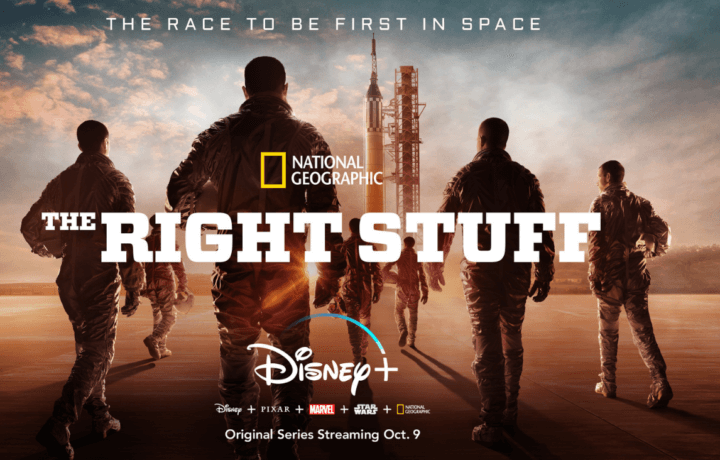The Disney+ series The Right Stuff, which debuted earlier this month, presented a look at the origins of NASA’s space program and provided a compelling look at the heroic yet flawed Mercury 7 astronauts. One notable point made in the series – which is based on Tom Wolfe’s 1979 bestselling book, is that those space pioneers such as Alan Shepard, John Glenn, and Gus Grissom all came from a similar background.
All were military aviation test pilots.
Special aviation consultant Carl Pascarell, who provided his insight for the show’s creators, explained that in the case of the Mercury 7, they were military aviators that stepped up to take on the next challenge.
“They didn’t even have a name for what these people would take on – the term astronauts had to be developed,” Pascarell told ClearanceJobs. “NASA, which was in its infancy, wasn’t sure if they wanted to send a pilot to space.”
The Space Task Force (STG), which was established at the NASA Langley Research Center in Hampton, VA, determined that as “aeronaut” had been a term coined for the air traveler, that “astronaut” would mean “star traveler.” The actual term had also been rooted in science fiction as far back as the 1920s – and it quickly stuck for those Americans who would venture into space.
In fact, there were many discussions over whether pilots would be best suited to the job, and aircraft pilots were considered but so too were submariners, deep sea divers, mountain climbers and even, according to some accounts, jockeys! However, in the end, it was determined that military test pilots would be the ideal candidates.
An important consideration was the security requirements, as the role of astronaut would certainly involve the handling of classified information. In the end, the panel drew up selection criteria and those included that would be astronauts must be less than 40 years old, less than five feet and 11 inches tall, in excellent physical condition, have a bachelor’s degree or equivalent, a graduate of a test pilot school with a minimum of 1,500 hours of flying time, and be a qualified jet pilot.
“It made sense that test pilots were selected as they were often more of an engineer would report back how an aircraft responded,” said Pascarell, who is a former Navy attack pilot and had flown A-7 Corsairs off aircraft carriers during the Vietnam War.
Becoming a Test Pilot
While NASA doesn’t just look to test pilots today, a question often asked is how one even becomes a test pilot today. Generally, a military background is a start, but Pascarell told ClearanceJobs that he is the exception to the rule.
Military aviators will typically go to the United States Naval Test Pilot School (USNTPS), located at Naval Air Station (NAS) Patuxent River, MD; or U.S. Air Force Test Pilot School (USAF TPS) at Edwards Air Force Base, CA; a third option is the National Test Pilot School (NTPS), which is a not-for-profit educational institution in Mojave, CA and the only civilian test pilot program in the United States.
“If you are a civilian, it is a lot harder as you don’t have the credentials,” explained Pascarell. “When you can say you went to the Naval Test Pilot School that opens doors, but in my case I did simply started flying very young. I had a degree in aerospace engineer, so that helped a lot.”
Eventually Pascarell was able to use his education and aviation experience to land the first job as a test pilot and it became much easier. It is a case where credentials truly matter.
Test Pilot Evolution
While the job that test pilots do today is largely the same as it was back in the days of the Space Race, those early Cold War pilots faced many new challenges and were thus aviation pioneers.
“In any era there has been aircraft evolution, but back in the days of the post World War II era supersonic flight was a big deal and that produced a need for a new breed of test pilots,” said Pascarell.
Yet, as aircraft have gotten more complex, the testing is actually easier today.
“From a normal pilot’s perspective he is often insulated from the difficult technological aspects of the latest ‘what it is’ that that should be invisible,” added Pascarell. “What remains the job of a test pilot is to convey the facets of how the new technology performs back to the engineers on the ground.”
In other words, test pilots aren’t daredevils or thrill seekers, but are aviation experts with master’s degrees in aerospace engineering who happen to be good pilots.
“The hard part isn’t the flying or the vibrato that you see in the movies and it is really a job that involves a lot of explain to engineers and conveying it terms so that issues can be resolved and problems can be fixed,” Pascarell noted. “We need to downplay the nerves of steel.”
The other thing that has changed is that much of this is worked out not in the skies overhead a test site, but on the ground in a computer simulation and then a wind tunnel. So while the test pilots turned early astronauts may have been explorers and adventurers, today a test pilot doesn’t climb into the cockpit until a lot of computer simulations have been run.
The one question that caught Pascarell off guard is to the future of test pilots.
“I don’t know,” he admitted candidly to ClearanceJobs. “Things are taking off in exponential rate. Clearly a test pilot will become more and more engineer-oriented to adequately describe and discuss the aircraft. But he or she will still have to maintain that level of hands on piloting. There are still times when a test pilot might have to do deal with things that go wrong.”




